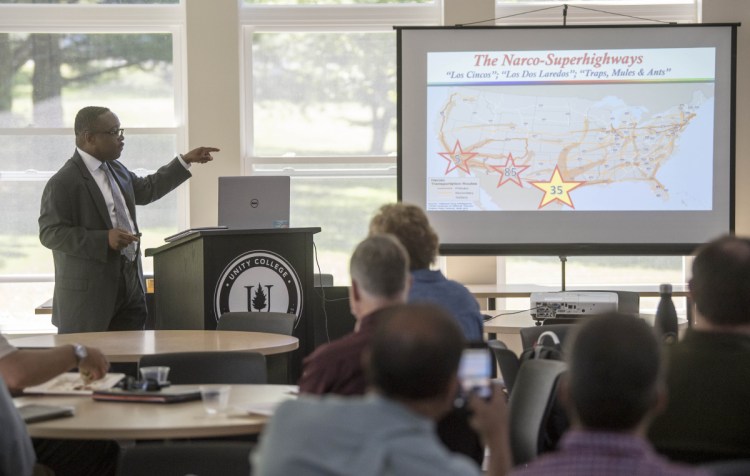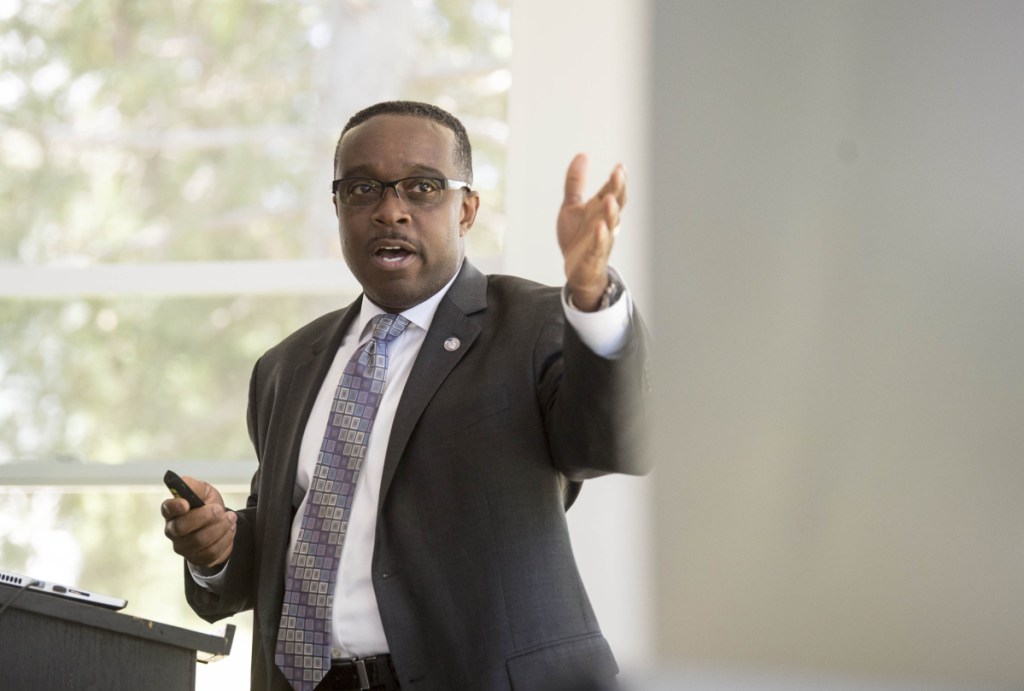UNITY — We are not going to arrest our way out of this.
The mantra has become a watchword for law enforcement agencies as they’ve grappled with how to respond to the heroin and opioid crisis that has ravaged communities across the United States, killing 418 people last year in Maine alone.
Karl Colder, who formerly served as the Drug Enforcement Administration’s special agent in charge of the Washington division and is now retired, said police departments and agencies have learned from past drug crises that incarcerating addicted populations is not a solution to what is now perceived as a public health problem.
Colder was speaking to a crowd of about 40 including law enforcement, first responders, school administrators and other community stakeholders from across the state Friday afternoon during his keynote address at Unity College’s first-ever Public Safety and Crisis Management Institute.
The two-day seminar, which was organized by Unity’s chief diversity and inclusion officer, Rana Johnson, aimed to expand community leaders’ knowledge to help them respond and manage crisis situations to meet the needs of the constituents they serve.
Presentation topics included active shooters, crowd management, disaster and emergency management plans, bereavement and death notification, environmental protection including bomb threats, and chemical safety and hazardous materials management.
The institute’s aim was to enhance participants’ cultural competency skills to address significant demographic shifts across the nation. On Thursday, panelists who work in law enforcement, community outreach and refugee resettlement discussed how to be proactive in crisis management plans and how to be collaborative in diverse communities.
Colder’s speech was the main draw Friday, as he described response models law enforcement agencies can use to help save addicts’ lives.
Before launching into the solutions, Colder laid out how the country into an opioid crisis. He said it began primarily with doctors overprescribing pain medication, such as hydrocodone, to the extent that patients became dependent upon it and subsequently addicted.
The crisis also has been aided by an existing heroin culture in areas such as Baltimore as well as young people experimenting with pills.
But as those addicted people run out of opioids or no longer can afford them, they turn to heroin — which is more addictive and less expensive.
Now, Colder said, fentanyl, a powerful synthetic that is 50 times more potent than heroin, is making up a larger portion of the drug market. Unlike heroin, fentanyl can be made in a laboratory and is easier to smuggle because it’s sold in tiny doses.
The first step in resolving the crisis is accepting that it’s not going to go away on its own.
“We used to say it’s just an inner-city problem. We used to say it will go away on its own,” he said. “It’s not going away. So we need to educate, protect and treat.”
Response model law enforcement ought to involve metrics, mapping and best practices, which help save the lives of those addicted.
Collaboration through three basic pillars, including public health, law enforcement and community, should all be a part of the response, Colder said.
The Waterville Police Department uses this type of model for its Operation HOPE (Heroin Opiate Prevention Effort), which aims to place people in treatment facilities rather than incarcerate them.
Reviving people who overdose by using naloxone is an important piece of the response, Colder said, and the state has embraced it as a way to prevent more deaths — but police need to work with the victims after overdoses to find their suppliers.
When an officer responds to an overdose, he said, they should be trying to gather data. The most critical data comes from the victim’s cellphone. The victim’s dealer probably would be the last person with whom the victim was in contact. That data then can be plugged into a database or shared with other agencies at the state and federal level, and it will help investigators locate the high-level conspirators.
One phone number that was collected by Colder’s division helped the group solve 10 homicides in Virginia and shut down two cliques that were a part of MS-13, an international criminal gang that originated in Los Angeles, California.
In addition to helping target big-time dealers, the data also helps pinpoint overdose hotspots so agencies know where to place treatment and harm reduction resources.
By using this model, Colder said police could be “smart on crime” without being “tough on crime.”
Emily Higginbotham — 861-9239
ehigginbotham@centralmaine.com
Send questions/comments to the editors.






Success. Please wait for the page to reload. If the page does not reload within 5 seconds, please refresh the page.
Enter your email and password to access comments.
Hi, to comment on stories you must . This profile is in addition to your subscription and website login.
Already have a commenting profile? .
Invalid username/password.
Please check your email to confirm and complete your registration.
Only subscribers are eligible to post comments. Please subscribe or login first for digital access. Here’s why.
Use the form below to reset your password. When you've submitted your account email, we will send an email with a reset code.